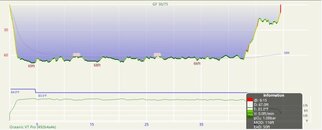Do you download your dives? You can probably, in retrospect, figure out your CNS loading for some of your past dive days giving credit the 90 minute half time, and also your cumulative OTUs. I can do that on Diving Log. I doubt you have a problem there, but it might be interesting. This would give some hard data and might provide comfort, or caution, for future diving. You can see just how close you came, if at all, to CNS limits on the other methodology. OTUs would be interesting too as keeping those in check is a good thing if you have have to hit the chamber, though I doubt you have an issue there.
Just keep in mind that oxygen toxicity in divers is not well understood. The "oxygen clock" is not a precise description of a known physiologic process. It is an attempt to rationalize empirical data and provide guidance for planning. It is a rough tool for something that we don't fully understand.
Much of the data comes from other applications, like hyperbaric therapy and anesthesiology and is applied to diving in the hope that it is instructive. But, it is not perfect. Consider:
- The exact mechanisms for why humans seem to tolerate much higher partial pressures of oxygen in a dry chamber versus immersion (which is a fact) are not fully understood.
- It is also known that we tolerate high PO2 better during resting portions of the dive, like decompression. This is why technical divers usually apply different PO2 limits for different parts of the dive.
- Air breaks on deco seem, empirically, to be more useful than the models would suggest, so we do it. But, the models don't really explain why it is effective.
- We also do not fully understand all the other risk factors for CNS problems -- CO2 retention, medications, nitrogen loading, physical fitness, etc. nor do we have a firm measure of how much of a role exertion plays, though we know it does.
Technical divers push or exceed 100% CNS all the time, but usually on deco in shallow water, where we know it is far better tolerated. They also push PO2 to 1.6 routinely at gas switches and at 20 feet on O2. But, they would never do that during the "working" portion of a dive.
All that is a long way of saying that caution is appropriate when borrowing experience from other divers, diving different profiles, etc. What is "safe" (relatively) on the deco bar is considered unacceptable at 100', particularly if you are swimming against a current and working hard. It is a very complicated subject.




